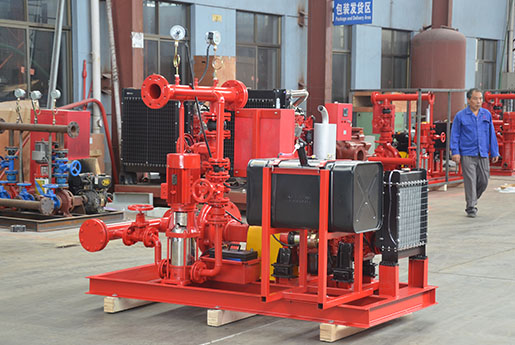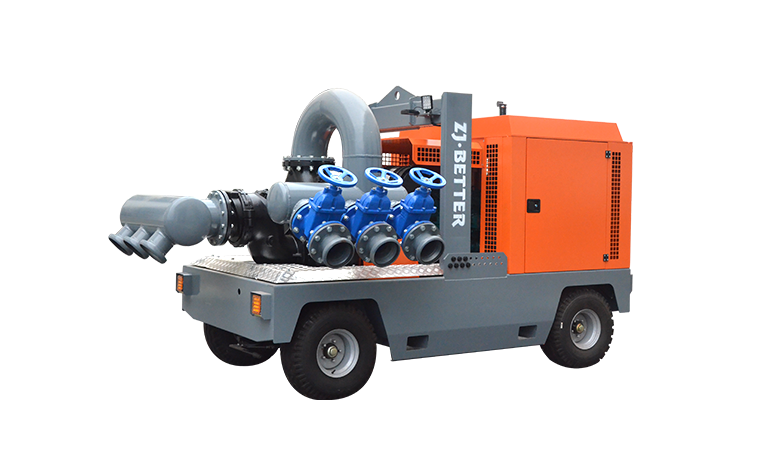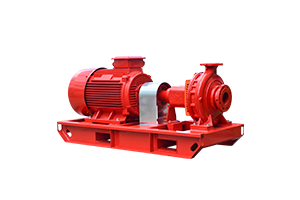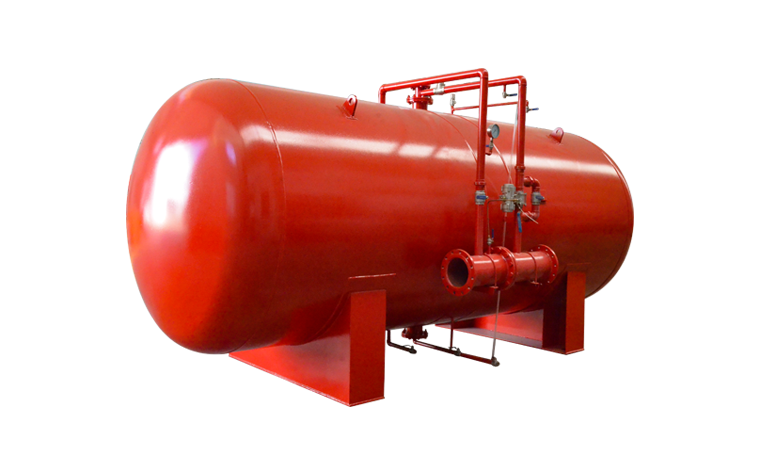-
 Jul 18, 2023How to solve the failure of fire pump safety valve?The safety valve on a fire pump is a critical component that protects the system from overpressure. If the safety valve fails, it can lead to potentially dangerous situations. Here are steps to solve the failure of a fire pump safety valve:
Jul 18, 2023How to solve the failure of fire pump safety valve?The safety valve on a fire pump is a critical component that protects the system from overpressure. If the safety valve fails, it can lead to potentially dangerous situations. Here are steps to solve the failure of a fire pump safety valve:
Isolate the System: If you notice any issues with the safety valve, immediately isolate the fire pump system by shutting it down. This will prevent further damage and ensure the safety of personnel and the surrounding area.
Inspect the Valve: Carefully inspect the safety valve to identify any visible signs of damage, wear, or malfunction. Look for leaks, cracks, or any abnormalities that might be causing the failure.
Clean the Valve: In some cases, the safety valve might fail due to debris or dirt obstructing its operation. Clean the valve thoroughly, removing any contaminants that might be affecting its performance.
Check the Pressure Setting: Verify that the safety valve's pressure setting is correct. It should be calibrated to release excess pressure at the designated level to prevent overpressure in the system.
Check for Proper Installation: Ensure that the safety valve is installed correctly and that all connections are secure. Improper installation can lead to leaks and failures.
Replace Faulty Components: If you identify any damaged or worn-out parts within the safety valve, replace them with new, compatible components. It's essential to use manufacturer-approved parts to maintain the valve's integrity.
Perform System Tests: After resolving the issues with the safety valve, conduct comprehensive tests on the fire pump system to ensure that the valve functions correctly under various operating conditions.
Consider Professional Inspection: If you are unsure about diagnosing or fixing the safety valve issue, consider contacting a qualified fire pump technician or a certified professional to inspect and repair the valve. They will have the expertise to identify and address the problem effectively.
Implement Regular Maintenance: To prevent future failures, establish a regular maintenance schedule for the fire pump system, including routine checks of the safety valve. Regular maintenance helps to identify potential issues before they escalate into significant problems.
Follow Manufacturer Guidelines: Always follow the manufacturer's guidelines for installation, operation, and maintenance of the fire pump and safety valve. These guidelines are designed to ensure the proper functioning and safety of the equipment.
Remember, a malfunctioning safety valve compromises the reliability of the fire pump system, so prompt action and proper resolution are essential to maintain the pump's effectiveness in emergency situations.
View details -
 Jul 17, 2023Basic composition of fire pump knife gate valve and pneumatic actuatorA fire pump knife gate valve with a pneumatic actuator consists of two main components: the knife gate valve itself and the pneumatic actuator that controls the valve's opening and closing. Let's look at the basic composition of each component:
Jul 17, 2023Basic composition of fire pump knife gate valve and pneumatic actuatorA fire pump knife gate valve with a pneumatic actuator consists of two main components: the knife gate valve itself and the pneumatic actuator that controls the valve's opening and closing. Let's look at the basic composition of each component:
1. Knife Gate Valve:
The knife gate valve is a specific type of valve designed to provide a tight shut-off in applications where a free-flowing, unobstructed passage is not required. It is commonly used in systems where on/off control or isolation of the flow is necessary, such as fire protection systems. The basic composition of a knife gate valve includes:
Valve Body: The main casing of the valve that houses the gate and provides the flow path. The body is typically made of cast iron, stainless steel, or other materials suitable for the application.
Gate: The gate is a flat or beveled plate that moves in and out of the flow path to control the water flow. It is the primary component responsible for opening and closing the valve.
Seat: The seat is a soft or resilient material lining the valve body, which helps create a tight seal when the gate is closed. The seat prevents water leakage when the valve is shut.
Stem: The stem is a rod or shaft that connects the gate to the actuator. It transmits the actuator's movement to the gate, enabling the valve to open and close.
2. Pneumatic Actuator:
The pneumatic actuator is a device responsible for controlling the movement of the gate in the knife gate valve using compressed air. It converts the energy of the compressed air into mechanical motion to open or close the valve. The basic composition of a pneumatic actuator includes:
Actuator Housing: The outer casing of the actuator, which encloses and protects the internal components. It is usually made of metal or other durable materials.
Diaphragm or Piston: The diaphragm or piston is a flexible element inside the actuator that moves in response to changes in air pressure. When air is supplied, the diaphragm or piston moves, transferring the force to the gate and causing it to open or close.
Spring: The spring provides a closing force in the actuator. When air pressure is reduced, the spring pushes the diaphragm or piston back to its original position, closing the valve.
Air Inlet/Outlet Ports: These are the connections through which compressed air is supplied to and released from the actuator. The air inlet port controls the actuator's movement, while the outlet port vents the air to release pressure.
Position Control Mechanism: The actuator may have a mechanism to control the valve's position within the flow path. This allows for partial opening or throttling of the valve for flow control.
Emergency Shutdown Features: Pneumatic actuators may include fail-safe features to allow manual operation or automatic closing of the valve in case of emergencies or power failure.
Overall, the combination of a knife gate valve and a pneumatic actuator provides an efficient and reliable solution for controlling water flow in fire protection systems, ensuring quick response times and accurate flow control during firefighting operations.
View details -
 Jul 17, 2023Fire pump valve working principleThe working principle of a fire pump valve is to control the flow of water within a fire protection system, ensuring that water is available when needed to combat fires. Fire pump valves are essential components of fire protection systems, such as sprinkler systems or hydrant systems, which rely on pressurized water to suppress or extinguish fires.
Jul 17, 2023Fire pump valve working principleThe working principle of a fire pump valve is to control the flow of water within a fire protection system, ensuring that water is available when needed to combat fires. Fire pump valves are essential components of fire protection systems, such as sprinkler systems or hydrant systems, which rely on pressurized water to suppress or extinguish fires.
Here's how the fire pump valve works:
Water supply connection: The fire pump valve is connected to the water supply, which could be a public water main, water tank, or other water source. The valve is typically located between the water supply and the fire pump.
On/off control: Fire pump valves are used for on/off control of water flow. When the valve is open, water is allowed to flow through the fire pump and into the fire protection system. This allows water to reach the sprinkler heads, hydrants, or other firefighting equipment.
Automatic operation: Some fire pump valves are designed to open and close automatically in response to pressure changes or fire detection systems. When a fire is detected, the valve will open, allowing water to flow into the system and suppress the fire.
Pressure regulation: Fire pump valves may include pressure regulation features. These valves are designed to maintain a specific pressure within the fire protection system. If the pressure exceeds a certain threshold, the valve will open to release excess pressure, preventing damage to the system.
Check valve function: In some cases, fire pump valves may also act as check valves. Check valves allow water to flow in one direction only, preventing backflow from the fire protection system into the water supply. This ensures that the water supply remains uncontaminated and that water is always available for firefighting purposes.
Emergency shutdown: Fire pump valves should have a manual override or emergency shutdown feature, allowing firefighters or system operators to quickly and safely stop water flow in case of emergencies or system malfunctions.
It's important to note that fire pump valves should be regularly inspected, tested, and maintained to ensure their proper functioning. Proper maintenance helps ensure that the fire protection system operates effectively and remains ready to respond to potential fire incidents. Regular testing is also crucial to verify that the valves open and close as expected and that the system is operating within the required pressure range.View details -
 Jul 14, 2023How to adjust the fire pumpAdjusting a fire pump typically involves modifying its operating parameters to achieve the desired flow rate and pressure. Here are the general steps to adjust a fire pump:
Jul 14, 2023How to adjust the fire pumpAdjusting a fire pump typically involves modifying its operating parameters to achieve the desired flow rate and pressure. Here are the general steps to adjust a fire pump:
Determine the Required Flow and Pressure: Understand the specific requirements of the fire protection system you are working with. This includes knowing the required flow rate and pressure as specified by the relevant codes, standards, or engineering design.
Familiarize Yourself with the Pump: Get acquainted with the fire pump's operating manual, including any specific instructions or guidelines provided by the manufacturer. Understand the pump's performance characteristics, such as its performance curve, maximum rated flow and pressure, and control mechanisms.
Adjust the Speed (if applicable): If the fire pump has variable speed control, adjust the speed to an appropriate level based on the system requirements. Increasing the speed generally increases both the flow rate and pressure output, while decreasing the speed reduces them.
Check and Adjust the Pump Suction: Ensure that the pump suction line is properly primed, free from air pockets, and that the suction valve is fully open. If necessary, adjust the suction valve to achieve the desired flow.
Adjust the Discharge Pressure: Use the pump's discharge pressure control device, such as a pressure relief valve or pressure regulating valve, to set the desired pressure. Follow the manufacturer's instructions for adjusting the pressure control device.
Monitor and Verify: Once you have made adjustments, closely monitor the pump's performance by checking the flow rate, pressure, and other relevant parameters using appropriate instruments or gauges. Verify that the pump is operating within its design limits and meeting the required specifications.
Fine-tune and Recheck: If necessary, make further adjustments to optimize the pump's performance and ensure it meets the system requirements. This may involve adjusting the speed, pressure control settings, or other relevant parameters.
Document the Adjustments: Keep a record of the adjustments made, including the initial and final settings of the pump's parameters. This documentation can be valuable for future reference, maintenance, and troubleshooting purposes.
Remember that fire pump adjustment should be performed by trained personnel familiar with the specific pump and its control mechanisms. It is crucial to follow the manufacturer's guidelines, relevant codes and standards, and consult with a fire protection professional or engineer if needed.
View details -
 Jul 14, 2023Fire pump head, flow and power relationshipThe relationship between fire pump head, flow, and power can be described by the principles of fluid dynamics and pump performance curves. Let's break it down:
Jul 14, 2023Fire pump head, flow and power relationshipThe relationship between fire pump head, flow, and power can be described by the principles of fluid dynamics and pump performance curves. Let's break it down:
Fire Pump Head: The head refers to the pressure or energy imparted by the fire pump to the fluid (typically water) to overcome resistance and lift the water to the required height. It is measured in units of length (feet or meters) or pressure (psi or bar). The head represents the total resistance the pump needs to overcome, including friction losses in the pipes, fittings, and other hydraulic components.
Flow Rate: The flow rate is the volume of fluid (water) that the fire pump can deliver in a given time. It is typically measured in gallons per minute (GPM) or liters per second (L/s). The flow rate depends on the size and design of the pump, as well as the system's demand and required fire protection standards.
Power: The power requirement of a fire pump is the energy it needs to deliver the desired flow rate against the specified head. Power is usually measured in horsepower (HP) or kilowatts (kW). It represents the rate at which work is done to move the fluid through the pump and overcome the resistance in the system.
The relationship between these variables can be represented by the pump performance curve, also known as the pump characteristic curve. It provides information about the pump's behavior, including the relationship between head, flow, and power. The curve shows how the pump's head and flow rate vary with different power inputs.
In general, as the desired flow rate increases, the pump's head also increases due to the increased resistance in the system. Consequently, the power required by the pump also increases to maintain the desired flow and overcome the higher head.
It's important to note that the specific relationship between head, flow, and power varies depending on the pump type, design, and system characteristics. Pump manufacturers provide performance data and curves for their products, which can be used to determine the appropriate pump for a given application and to understand the relationship between head, flow, and power.
View details -
 Jul 13, 2023What is the effect of fire pump outlet pipe height on self-priming performance?The outlet pipe height of a fire pump can have an impact on the self-priming performance. Self-priming refers to the ability of a pump to evacuate air from the suction line and create a vacuum to draw in water, allowing the pump to operate efficiently. Here's how the outlet pipe height can affect self-priming performance:
Jul 13, 2023What is the effect of fire pump outlet pipe height on self-priming performance?The outlet pipe height of a fire pump can have an impact on the self-priming performance. Self-priming refers to the ability of a pump to evacuate air from the suction line and create a vacuum to draw in water, allowing the pump to operate efficiently. Here's how the outlet pipe height can affect self-priming performance:
Height Limitations: Fire pumps have limitations on the maximum height they can effectively self-prime against. The self-priming capability of a pump is typically specified by the manufacturer and is influenced by factors such as the pump design, impeller type, and motor power. If the outlet pipe height exceeds the pump's self-priming limit, the pump may struggle to prime or fail to prime altogether.
Suction Lift: The outlet pipe height contributes to the total suction lift of the pump. Suction lift is the vertical distance between the water level and the pump's centerline. As the outlet pipe height increases, the suction lift also increases. Higher suction lifts can negatively impact self-priming performance because the pump has to work against a greater head pressure to draw water into the system.
Priming Time: The outlet pipe height can affect the priming time required for the pump to evacuate air and establish water flow. A higher outlet pipe height may result in a longer priming time as the pump needs to overcome a greater head pressure to fill the suction line and prime the pump. This can lead to delays in getting the pump operational.
Pump Design and Features: Some fire pumps are specifically designed to handle higher outlet pipe heights and maintain efficient self-priming performance. These pumps may incorporate features like larger impellers, increased motor power, or specialized priming systems to overcome the challenges posed by higher outlet pipe heights. It's important to consult the manufacturer's specifications and guidelines to determine the suitability of a particular fire pump for a given outlet pipe height.
In summary, the outlet pipe height of a fire pump can impact its self-priming performance. It is crucial to consider the manufacturer's specifications and limitations regarding self-priming capabilities and outlet pipe height to ensure the pump operates effectively and efficiently.
View details

.png)
.png)

.png)


